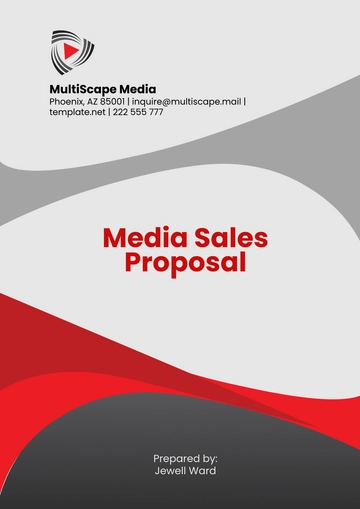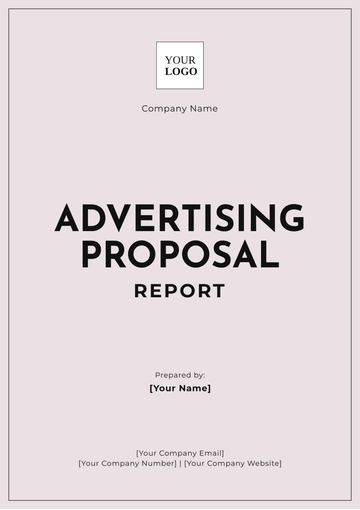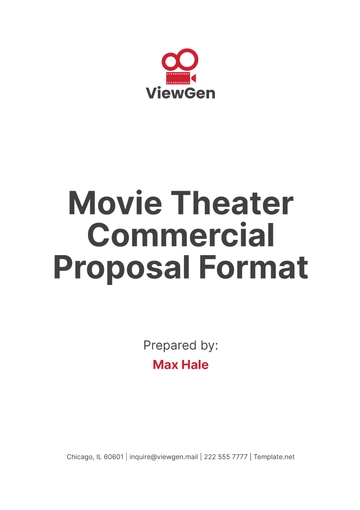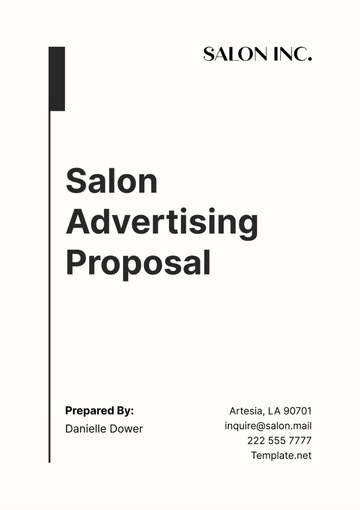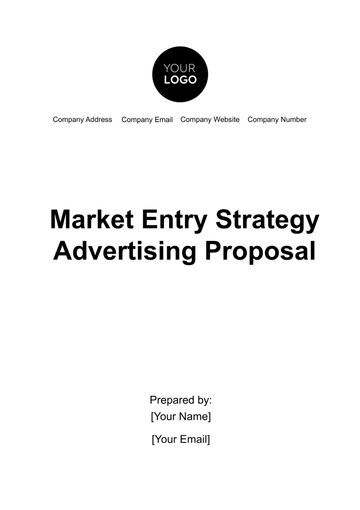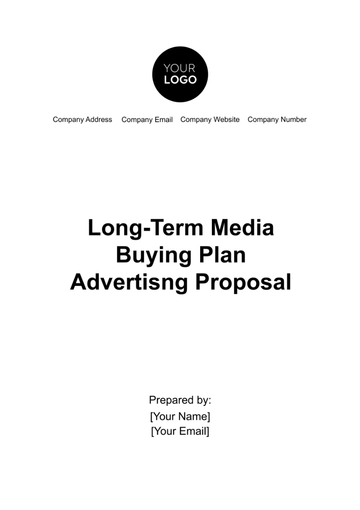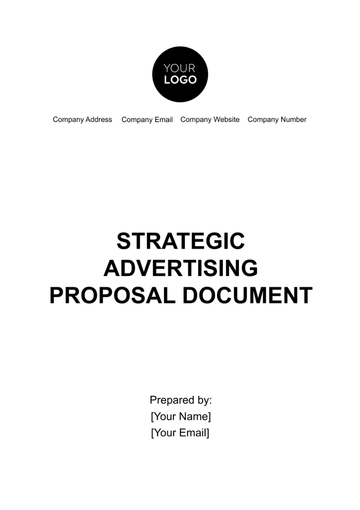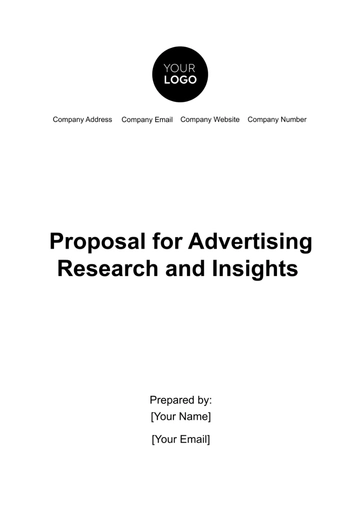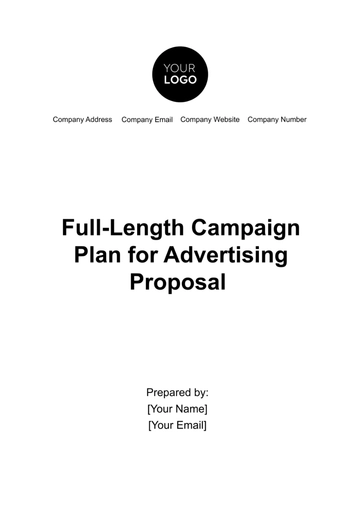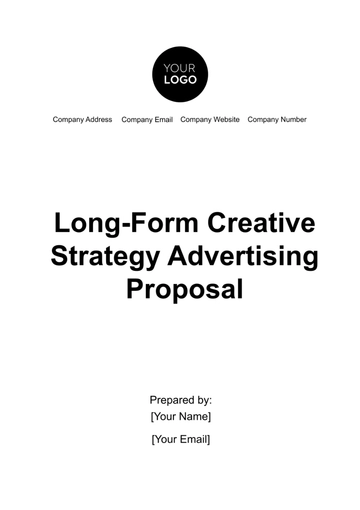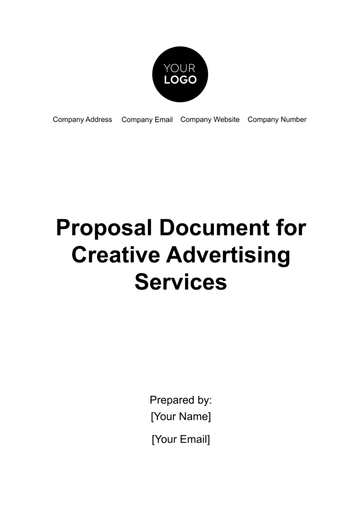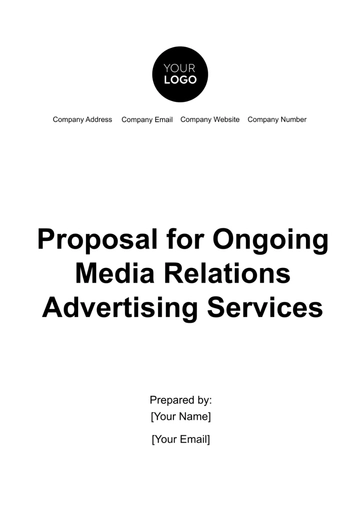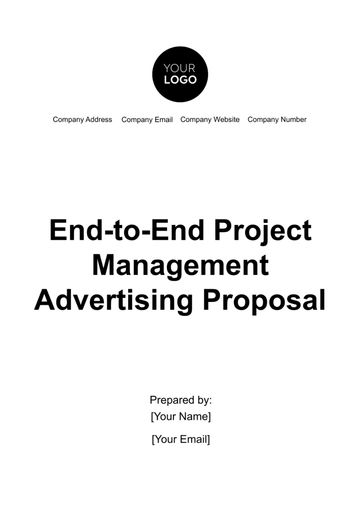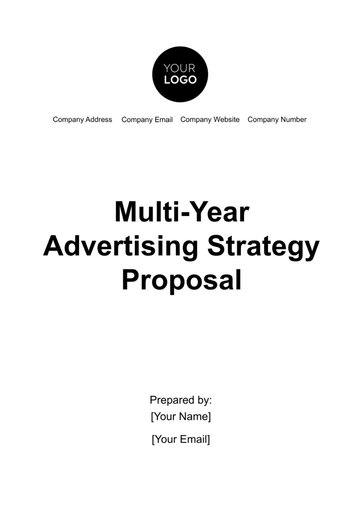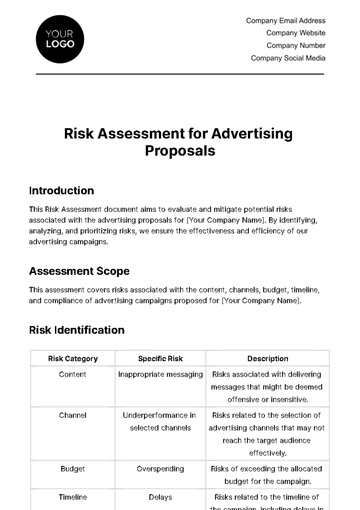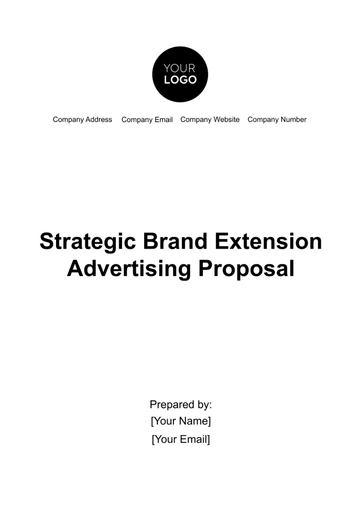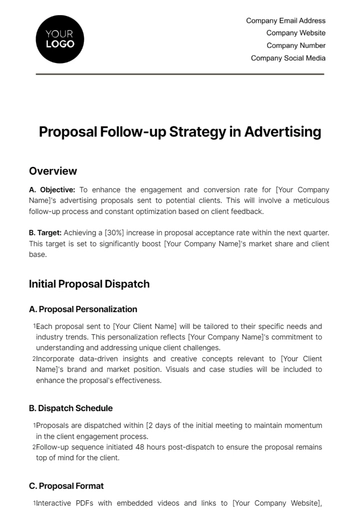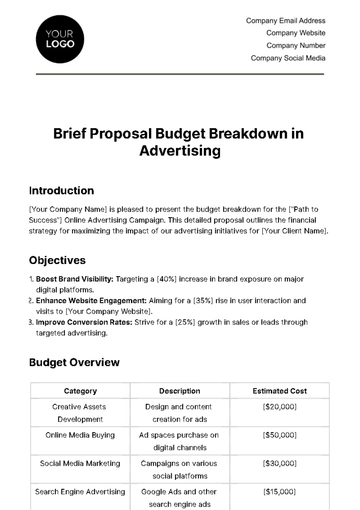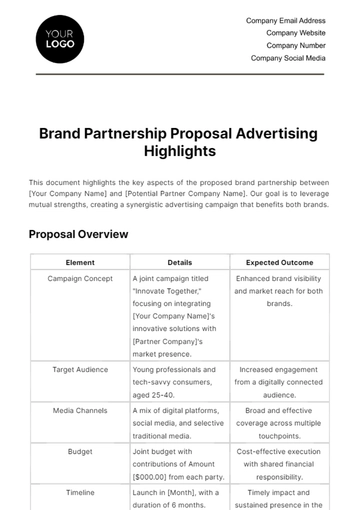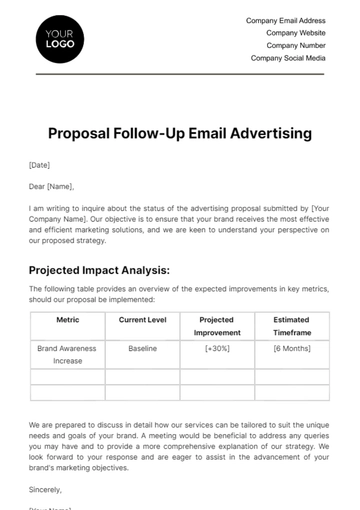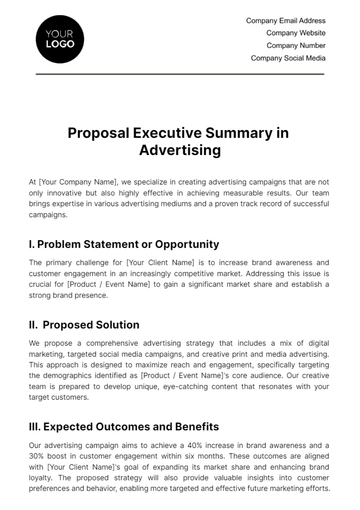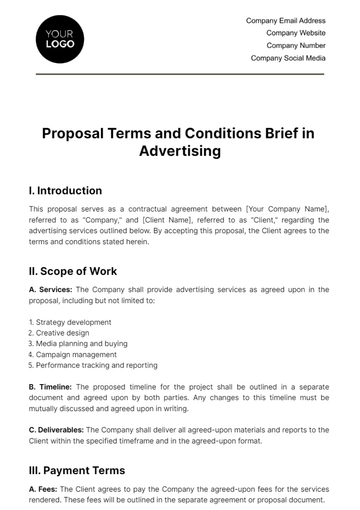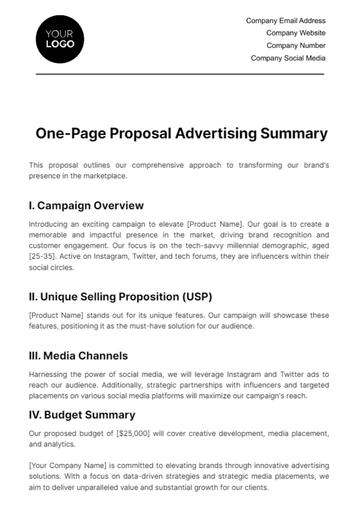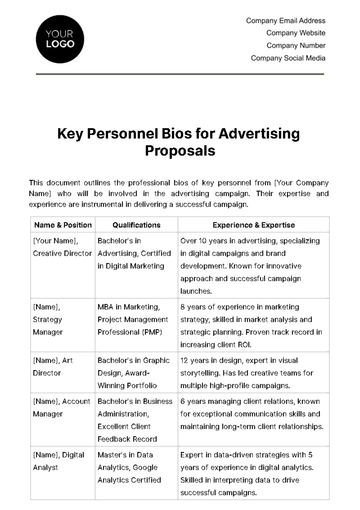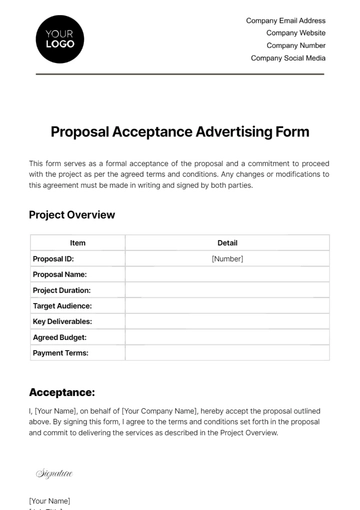Free Advertising Integrated Media Proposal
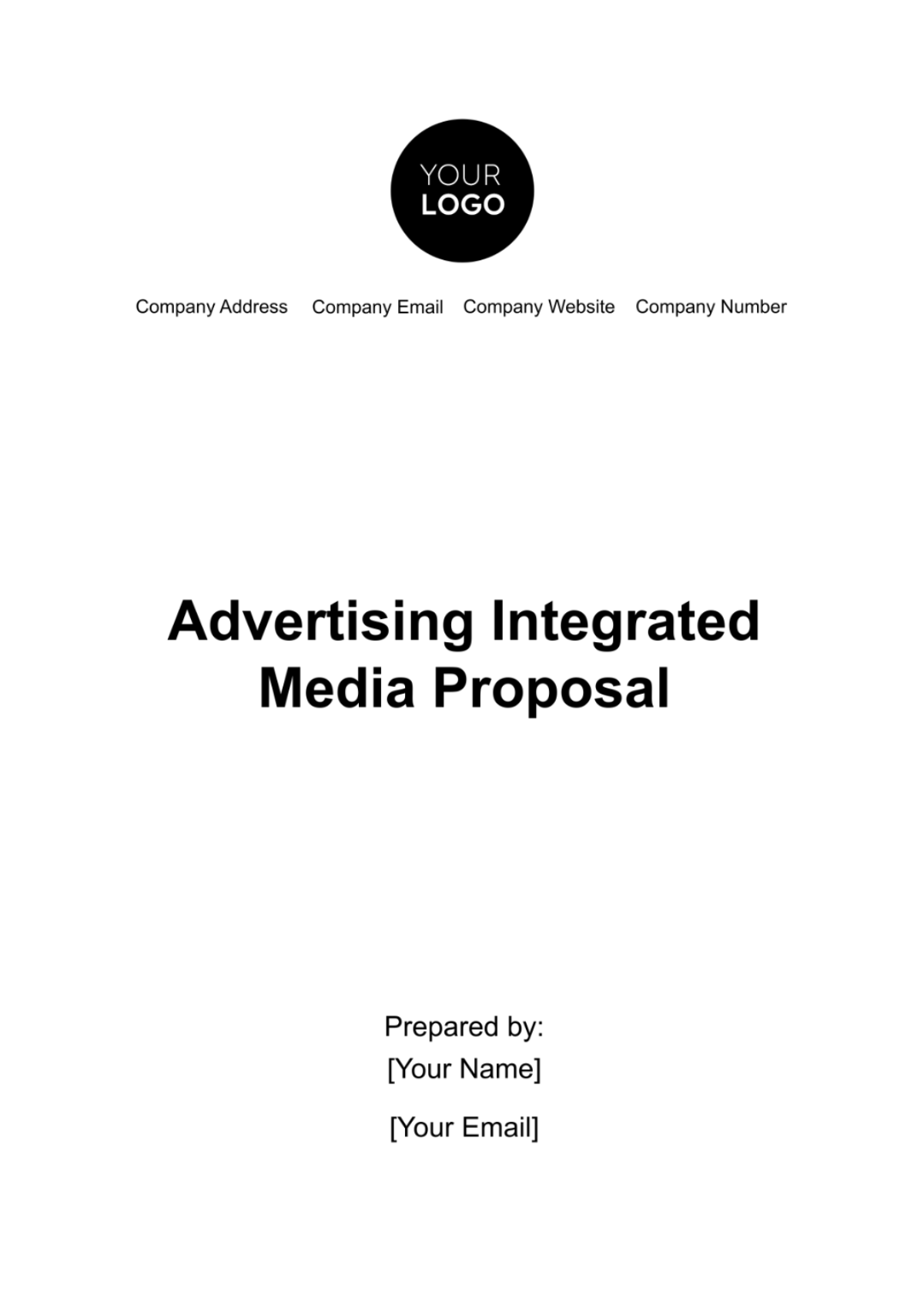
I. Introduction
Establishing a strong and dynamic presence in the market is, and should always be the top priority of any company. As such, this proposal aims to uncover a comprehensive integrated media strategy meticulously designed to elevate [Your Company Name]'s brand visibility and engagement.
Making [Your Company Name]’s brand stand out will require our advertising teams’ utmost efforts. Strategy, creativity, and a deep understanding of consumer behavior would be most desired when it comes to advertising, and it is absolutely crucial to recognize that [Your Company Name] is not merely a name within the industry, but should also be a name within our consumers’ households.
A. Advertising Objectives
Our advertising objectives serve as the compass that will guide us towards greater brand recognition and customer engagement. These objectives have been formulated based on extensive research and a thorough understanding of market trends and consumer behavior.
Increase overall brand awareness the next quarter:
Brand awareness is the foundation for brand success. To ensure that [Your Company Name] is top of mind for consumers, our primary objective is to achieve a [30% increase] in overall brand awareness within the next quarter, via online or poster ads. This will not only place us ahead of our competitors but also solidify our position as an industry leader.
Boost online sales:
The online marketplace offers boundless opportunities for growth. With the e-commerce sector expanding rapidly, it is essential that we leverage this platform. Our second objective is to boost online sales by [20%], effectively utilizing the power of integrated media strategies to drive conversions and revenue.
Enhance customer engagement across all media platforms:
Our goal is to create many meaningful connections with our audience. We aim to enhance customer engagement across all media platforms, nurturing relationships that could be seen as more than just transactional interactions. This objective aligns with research findings, which reveal that engaged customers are more likely to become brand advocates, leading to increased loyalty and advocacy.
Our integrated media strategy serves as a roadmap towards future successes. Backed by data and case studies, [Your Company Name] is poised for brand elevation and visibility that will eventually drive online sales, which in turn will forge deeper connections with our customers.
II. Target Audience Analysis
In this section, we will go through the comprehensive analysis of our target audience. This analysis will cover both the demographic and psychographic dimensions of our primary target audience, shedding light on who they are, what they value, and how they behave.
A. Demographic Profile
Primary audience:
Our primary audience comprises a diverse group of individuals, primarily ranging from the ages of [25 to 40]. They reside in urban settings, mirroring the evolving landscape of consumer behavior as more individuals migrate to urban areas. Importantly, this demographic segment typically falls within the middle to upper-middle income brackets, affording them a degree of disposable income.
Lifestyle:
A defining characteristic of our primary audience is their tech-savvy nature. They are intimately familiar with digital technologies, relying on them for a multitude of tasks and as a source of information and entertainment. Quality and sustainability are paramount in their purchasing decisions, reflecting a conscious effort to make choices that align with their values and the long-term impact on the environment.
B. Psychographic Profile
Values:
The psychographic profile of our audience reveals a deep-rooted commitment to values that extend beyond personal gain. They are environmentally conscious, demonstrating a genuine concern for the planet and a desire to make choices that reduce their ecological footprint. Additionally, they prioritize their health, seeking products and services that contribute to their overall well-being. The affinity for technology is another prominent aspect of their lives, as they readily embrace innovations that enhance convenience and efficiency.
Behavior:
Our audience's behavior is closely aligned with the digital age. They are highly active on social media platforms, engaging with content, sharing their experiences, and seeking inspiration from their online communities. This propensity for online interaction translates into a receptiveness to online advertising, making digital channels a pivotal component of our strategy. Furthermore, their preference for online shopping aligns seamlessly with our goal to boost online sales.
Our target audience analysis reveals a diverse group of individuals who are not just consumers but active participants in a digital and socially conscious world. By understanding their demographics, values, and behaviors, [Your Company Name] now understands and knows how to tailor its messaging and engagement strategies to resonate with this audience effectively.
III. Integrated Media Strategy
This section examines our meticulously crafted integrated media strategy, which is designed to ensure that [Your Company Name] reaches its target audience through a blend of digital and traditional media channels. We will explore our media channel selection and the strategic underpinnings that unify our messaging and enhance our campaign's effectiveness.
A. Media Channel Selection
Digital Media:
Our choice to emphasize digital media is a reflection of the evolving media consumption habits of our audience. Specifically, we will leverage the power of social media platforms, such as Facebook and Instagram, where our audience is highly active and engaged. Additionally, Google AdWords will serve as a vital component of our digital strategy, enabling us to reach potential customers precisely when they are searching for products and solutions.
Traditional Media:
While the digital realm offers immense opportunities, we recognize the continued relevance of traditional media in certain scenarios. Therefore, we will deploy a selective approach to the use of print and broadcast media, focusing on major urban areas where these channels still hold sway. This strategic selection ensures that we capture the attention of our audience through the most effective channels, combining the strengths of both digital and traditional media.
B. Strategy for Integration
Unified messaging across all platforms:
We will employ unified messaging that carries a coherent narrative across all media platforms. Our messaging will be tailored to make the most of these strengths, ensuring that our content resonates with the audience while optimizing engagement and impact.
Use of data analytics to integrate campaigns:
We will leverage data analytics to integrate our campaigns seamlessly. By analyzing audience behavior, preferences, and response patterns, we can refine our messaging and delivery for maximum effect.
By strategically selecting digital and traditional media channels, unifying our messaging, and harnessing the power of data analytics, [Your Company Name] is poised to make a meaningful impact in the advertising landscape.
IV. Campaign Execution Plan
This section provides an in-depth look at our roadmap for campaign implementation, including key phases and resource allocation. Our approach is designed to ensure seamless coordination and optimal utilization of resources, delivering a unified and impactful advertising campaign.
A. Campaign Roadmap
Phase 1 (Month 1-2):
The initial phase of our campaign is characterized by momentum-building and establishing a strong online presence. During the first two months, we will execute a strong launch strategy, focusing on social media platforms such as Facebook and Instagram, which offer high engagement rates. Simultaneously, Google AdWords will be leveraged to capture the attention of potential customers actively searching for products like ours. This phase sets the stage for brand recognition and engagement.
Phase 2 (Month 3):
Building on the foundation laid in Phase 1, the third month marks a pivotal shift in our campaign. Here, we introduce the selective use of traditional media, including print and broadcast, in major urban areas. This integration is strategically timed to reinforce our messaging while capitalizing on the reach and impact of traditional media. Digital platforms will continue to play a significant role, ensuring that our message remains consistent across all channels.
B. Resource Allocation
Budget:
Effective resource allocation is essential for campaign success. With a budget of [$5,000,000], we have structured our allocation to maximize the impact of our integrated approach. The majority of our budget, [70%], will be dedicated to digital channels, reflecting the audience's online behavior and the high ROI associated with digital campaigns. The remaining [30%] will be allocated to traditional media to supplement our efforts in major urban markets.
Team:
The human element is equally crucial to campaign execution. To ensure the seamless execution of our integrated media strategy, we have a dedicated in-house digital marketing team equipped with the expertise needed to manage and optimize digital campaigns. Additionally, for our traditional media endeavors, we will collaborate with external media agencies with proven track records in print and broadcast advertising. This collaborative approach ensures that we have the specialized skills required for each channel.
Our campaign execution plan is a blueprint for translating strategy into action. By following the outlined roadmap, allocating resources effectively, and leveraging the expertise of both in-house and external teams, [Your Company Name] is well-positioned to execute a seamless and impactful advertising campaign that will resonate with our target audience.
V. Measurement and Evaluation
This section outlines the metrics we will employ to gauge the success of our integrated media strategy and the methodology we will use for evaluation.
A. Metrics for Success
Digital:
Our digital campaigns will be assessed through a combination of key performance indicators (KPIs) tailored to the digital landscape. These include engagement rates, which measure the level of interaction our content generates, website traffic, indicating the effectiveness of our campaigns in driving visitors to our online platforms, and conversion rates, which highlight the ability of our advertising efforts to translate into tangible actions, such as sales or sign-ups.
Traditional:
Reach and brand recall play pivotal roles for our evaluation metrics and will focus on these core aspects. We will monitor the extent to which our message reaches our intended audience and assess their ability to recall our brand and messaging. Additionally, response rates, gauging the audience's interaction with our traditional campaigns, will provide valuable insights into their effectiveness.
B. Evaluation Methodology
Monthly analytics reports:
We will employ monthly analytics reports that delve into the performance of our digital campaigns. These reports will cover engagement metrics, website traffic analysis, and conversion rate tracking. This frequent evaluation will allow us to make data-driven adjustments promptly and fine-tune our digital strategy for optimal results.
Quarterly market surveys:
Traditional media campaigns require a different approach to evaluation. To assess brand perception and recall, we will conduct quarterly market surveys. These surveys will provide qualitative and quantitative data on how our brand and messaging are resonating with the audience. We can gain valuable insights into the effectiveness of our traditional campaigns and make informed adjustments as needed.
Our measurement and evaluation approach is a fundamental component of our integrated media strategy. By utilizing a combination of digital and traditional metrics and a data-driven evaluation methodology, [Your Company Name] ensures that it remains agile and responsive throughout the campaign's duration.
VI. Conclusion
Our advertising integrated media proposal presents a comprehensive strategy to elevate [Your Company Name]’s brand's visibility and engagement across various channels. Our innovative approach leverages the strengths of each platform to maximize reach, enhance brand recall, and drive measurable results.
With a focus on creativity, data-driven insights, and strategic placement, we are confident that this integrated media plan will not only meet but exceed your marketing objectives. Let us embark on this collaborative journey to elevate your brand to new heights and leave a lasting impression on your audience.
- 100% Customizable, free editor
- Access 1 Million+ Templates, photo’s & graphics
- Download or share as a template
- Click and replace photos, graphics, text, backgrounds
- Resize, crop, AI write & more
- Access advanced editor
Discover the ultimate solution for crafting compelling advertising campaigns with the Advertising Integrated Media Proposal Template from Template.net. This editable and customizable template boasts an intuitive AI Editor Tool, empowering you to create tailored strategies across diverse media channels effortlessly. Elevate your proposals with precision and finesse, ensuring maximum impact and engagement with your target audience.
You may also like
- Business Proposal
- Research Proposal
- Proposal Request
- Project Proposal
- Grant Proposal
- Photography Proposal
- Job Proposal
- Budget Proposal
- Marketing Proposal
- Branding Proposal
- Advertising Proposal
- Sales Proposal
- Startup Proposal
- Event Proposal
- Creative Proposal
- Restaurant Proposal
- Blank Proposal
- One Page Proposal
- Proposal Report
- IT Proposal
- Non Profit Proposal
- Training Proposal
- Construction Proposal
- School Proposal
- Cleaning Proposal
- Contract Proposal
- HR Proposal
- Travel Agency Proposal
- Small Business Proposal
- Investment Proposal
- Bid Proposal
- Retail Business Proposal
- Sponsorship Proposal
- Academic Proposal
- Partnership Proposal
- Work Proposal
- Agency Proposal
- University Proposal
- Accounting Proposal
- Real Estate Proposal
- Hotel Proposal
- Product Proposal
- Advertising Agency Proposal
- Development Proposal
- Loan Proposal
- Website Proposal
- Nursing Home Proposal
- Financial Proposal
- Salon Proposal
- Freelancer Proposal
- Funding Proposal
- Work from Home Proposal
- Company Proposal
- Consulting Proposal
- Educational Proposal
- Construction Bid Proposal
- Interior Design Proposal
- New Product Proposal
- Sports Proposal
- Corporate Proposal
- Food Proposal
- Property Proposal
- Maintenance Proposal
- Purchase Proposal
- Rental Proposal
- Recruitment Proposal
- Social Media Proposal
- Travel Proposal
- Trip Proposal
- Software Proposal
- Conference Proposal
- Graphic Design Proposal
- Law Firm Proposal
- Medical Proposal
- Music Proposal
- Pricing Proposal
- SEO Proposal
- Strategy Proposal
- Technical Proposal
- Coaching Proposal
- Ecommerce Proposal
- Fundraising Proposal
- Landscaping Proposal
- Charity Proposal
- Contractor Proposal
- Exhibition Proposal
- Art Proposal
- Mobile Proposal
- Equipment Proposal
- Student Proposal
- Engineering Proposal
- Business Proposal

